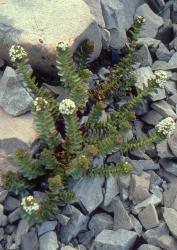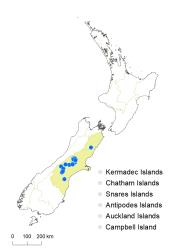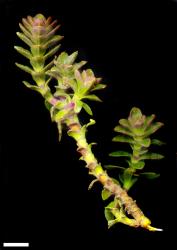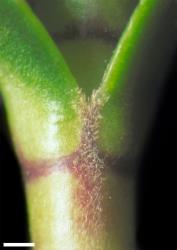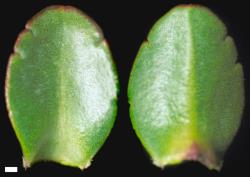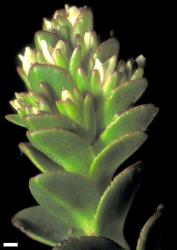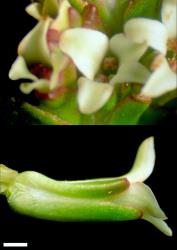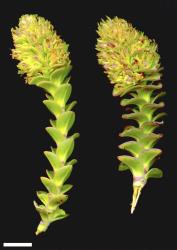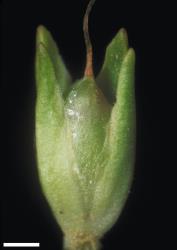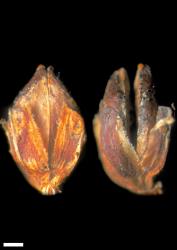- Taxon
- Gallery
- ≡ Hebe haastii (Hook.f.) Cockayne & Allan, Trans. New Zealand Inst. 57: 42 (1926)
- ≡ Leonohebe haastii (Hook.f.) Heads, Bot. Soc. Otago Newsl. 5: 6 (1987)
Sub-shrub or low-spreading shrub to 0.2 m tall. Stems decumbent or ascending or spreading, eglandular-puberulent; hairs bifarious. Leaf bud distinct, its outer leaves fully grown, diverging. Leaves opposite-decussate, connate in pairs and encircling stem, erecto-patent; lamina coriaceous to fleshy, elliptic, obovate, ovate, or spathulate, 6.6–13.0 mm long, 4.2–11.6 mm wide, dull or glossy green or dark green above and beneath, or sometimes reddish beneath; midrib obscure above, slightly thickened beneath; surfaces glabrous; margin glabrous, entire or erose, crenulate, or shallowly to deeply toothed, green or red, teeth in 1–3 pairs; apex rounded to sub-acute; base cuneate, broad; petiole absent. Inflorescence a terminal compound spike, 8–33 mm long; flowers crowded, 4–6 per lateral spike, female or bisexual on separate plants, ⚥ > ♀; bracts opposite, or becoming alternate above, oblong, deltoid, or lanceolate, about = calyx; pedicels absent. Calyx lobes 4, sub-acute to obtuse, 4–5 mm long, sub-equal, ciliolate. Corolla 3.5–5.0 mm diameter, tube white, 3–6 mm long, about = calyx, glabrous; lobes 4, white, erecto-patent to spreading, unequal, elliptic or ovate, 1.5–3.0 mm long, sub-acute; nectar guides absent. Stamen filaments white, 0.1–0.4 mm long; anthers pink or magenta. Style glabrous, 2–4 mm long. Capsules latiseptate, sub-acute to acute, glabrous or rarely eglandular-hairy, 5–6 mm long, 2.5–3.7 mm at widest point. Seeds broadly ellipsoid, flattened, smooth, straw-yellow, 0.9–1.3 mm long.
Plants of V. haastii and V. macrocalyx are similar. V. macrocalyx is distinguished by the leaves being narrowed at the base into a distinct, short, broad petiole, longer and narrower calyx lobes, and smaller and more lax flowering heads. Usually some leaves of V. haastii are toothed, and the upper ones, within or near the flowering heads, are usually erose to crenulate. Although they are similar, their status as separate species is supported by chemical differences (Kellow et al. 2003).
V. epacridea and V. haastii plants can often be found growing together. V. epacridea can be distinguished by more rigid leaves, which are strongly keeled and thickened at the entire margin, and ciliate (rather than ciliolate) calyx lobes.
South Island: Marlborough (Mt Terako only), Canterbury (widespread in the eastern mountains from the Craigieburn Range to the Hunters Hills).
Alpine rock debris and scree. Recorded elevations range from 1200 to 2154 m.
Flowers: December–February; fruits: January–April (sometimes persisting to August).
2n = 42 (see Bayly & Kellow 2006, as Hebe haastii).
Veronica haastii is classified in V. subg. Pseudoveronica sect. Hebe and the informal group “Connatae” (Albach & Meudt 2010; Bayly & Kellow 2006). V. haastii is related to V. macrocalyx, V. epacridea, and V. kellowiae and this small group appears to be sister to V. odora and V. pauciramosa. V. petriei and V. murrellii are similar but appear not to be closely related to them.
The inflorescence is formed of 8–25 spikes each of 4–6 flowers, forming a compact, clavate, terminal compound spike.



